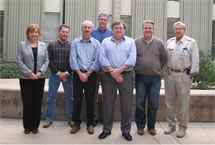
Handy Links
SLAC News Center
SLAC Today
- Subscribe
- Archives: Feb 2006-May 20, 2011
- Archives: May 23, 2011 and later
- Submit Feedback or Story Ideas
- About SLAC Today
SLAC News
Lab News
- Interactions
- Lightsources.org
- ILC NewsLine
- Int'l Science Grid This Week
- Fermilab Today
- Berkeley Lab News
- @brookhaven TODAY
- DOE Pulse
- CERN Courier
- DESY inForm
- US / LHC
SLAC Links
- Emergency
- Safety
- Policy Repository
- Site Entry Form

- Site Maps
- M & O Review
- Computing Status & Calendar
- SLAC Colloquium
- SLACspeak
- SLACspace
- SLAC Logo
- Café Menu
- Flea Market
- Web E-mail
- Marguerite Shuttle
- Discount Commuter Passes
-
Award Reporting Form
- SPIRES
- SciDoc
- Activity Groups
- Library
Stanford
Around the Bay
A Successful AED Improvement Initiative Review
Karen Fant and her Accelerator Engineering Division management team are all breathing a sigh of relief after three days of scrutiny by external reviewers from October 27 through October 29. AED is the organization within the Accelerator Directorate that puts the "engineering" into the accelerator—getting the power, designing and building hardware, creating software, and measuring everything to the sub-micron to help turn scientists' brilliant ideas into reality.
Bob Hettel, the acting director of the Accelerator Directorate, requested the review. The reviewers represented a broad managerial experience base from independent consultants to leaders of other national laboratories. They came to SLAC to assess the performance of AED and its constituent departments—Integrated Controls, Klystron/Microwave, Mechanical Engineering and Design, Mechanical Fabrication, Metrology, Power Conversion and Systems Engineering—and to identify opportunities to improve the cost-effective and efficient delivery of services. As an added bonus, the review was an opportunity for several AED leaders to meet the new director of the Accelerator Directorate, Norbert Holtkamp, who will officially report to SLAC on November 15.
Persis Drell opened the meeting with an overview of the SLAC mission, vision and current projects and programs. For the review committee's benefit, she also verbally sketched the reinvention of the laboratory from a sole-purpose, high-energy particle physics laboratory to its current, multi-program role. Bob Hettel, Cindy Lowe and Karen Fant presented overviews of the SLAC Agenda, financial model, and AED organization, respectively. AED department heads spent a day and a half describing their departments' missions, core competencies, rendering of services to customers and the problems that hinder providing those services efficiently. The reviewers also learned of the role that AED's new Conduct of Engineering Committee is playing.
A tour of AED facilities and the Next Linear Collider Test Accelerator provided additional insight into AED operations. Breakout sessions allowed the reviewers to speak with AED's customers as well as representatives from the Operations Directorate, Office of Planning and Assurance and Department of Energy Site Office, and to hear their opinions about AED-provided services. At the closeout session, the reviewers reported that the division has broad capabilities and a wide range of competencies. They felt that the new Conduct of Engineering manual would provide an integrated, consistent approach to good engineering practices. They recommended using the official budgeting process as the only process for AED budgeting and cost estimating. AD needs to ensure that financial tools and models, the information on overhead rates, and their implications are distributed and explained to the AED Director and department heads. The reviewers emphasized benchmarking of costs and services are good practices and suggested instituting them in all aspects of AED work.
The reviewers praised the tremendous effort by Karen Fant, the efforts of the AED staff and Barbara Hemstad's outstanding support, for making the review so productive and successful. In turn, Karen and AED staff thanked the reviewers for taking time from their busy schedules to participate in the review.
The AED staff welcomes and appreciates the reviewers' observations and will take them to heart. Of course, the "proof of the pudding" is in implementation, but AED is committed to betterment, so customers will soon see improvements and experience increased satisfaction.
—Paul Bellomo, deputy AED division director
SLAC Today, November 12, 2010
